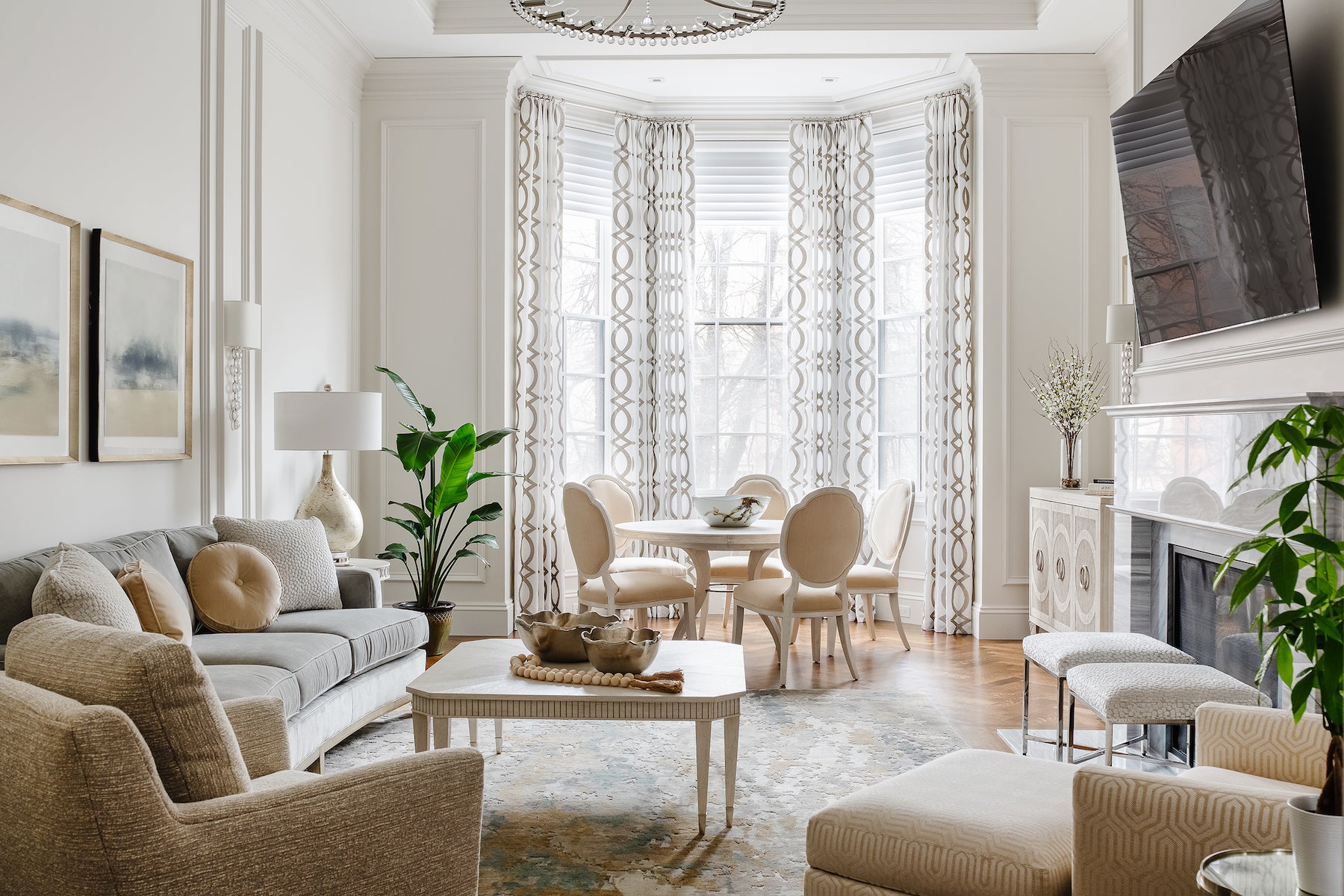What’s the largest design firm in America?
As is often the case, the answer depends very much on how you define the question. If you’re including companies that tackle skyscrapers and corporate offices, then the Genslers of the world have to be considered. If you include retailers, RH chairman and CEO Gary Friedman has claimed many times that his brand is the biggest residential design firm in the country, if not the world. Then there are the large-scale operations run by design-world celebrities: Joanna Gaines, Shea McGee, Amber Lewis and the like, each of whom employs more than 100 people.
All of those are good answers. But here’s another name to toss in the hat: Decorating Den. The Maryland-based interior design franchise often flies below the radar of national media attention, but has quietly maintained considerable scale. According to CEO Jim Bugg Jr., Decorating Den has around 250 franchises fanned out across the country. Even if each outpost had only one designer (many have far more), that’s a sizable operation. The company, founded in 1969, has demonstrated its staying power too. While there have been other attempts to bring the franchise model to interior design, none have gotten as big or lasted as long.
Decorating Den is not a flashy business. It remains family-owned, and Bugg doesn’t talk about disruption or taking over the world. But in its relative modesty, the company has managed a real feat: In an industry full of independent spirits, where no two firms are the same, it has held together what amounts to a large design operation, and it has done so for more than 50 years.
What about the next 50?
A TURNKEY BUSINESS MODEL
Interior design isn’t fast food, but for the sake of a useful analogy, the underlying business model behind Decorating Den is exactly like McDonald’s: a franchise system where individual operators obtain a license from the corporate office to open and run their own local branch. Only, in this case, the end result is a design firm, not a drive-thru.
There is an application process to join, but the company typically vets candidates for financial stability and a basic design skill set, not a specific look. To be sure, the general stylistic lean among Decorating Den designers is toward traditional and transitional—you’re not going to see wild Memphis Milano fantasias on the company’s website. But the style part is mostly left up to designers and their clients.
It’s not free to spin up a Decorating Den business, or to run one. The initial franchise fee is typically $39,900, and from there, there are further startup costs—things like insurance and office materials—that can tack on additional thousands. Once a firm is up and running, franchisees pay a cut of their gross revenue to the corporate office (the number is capped at a certain amount, but it ranges between 7 and 9 percent) as well as a contribution to a central marketing fund.

For that money, franchisees get a package of services that constitutes a kind of quick-start interior design business.
On the education side, Decorating Den runs new franchisees through an orientation program that covers the nuts and bolts of the business side of design. The company then offers seminars on a continuing basis to supplement designers’ education as they go.
For marketing, Decorating Den starts by helping franchisees develop materials and build a website, which they host. They can also have their work showcased in advertising campaigns that the company pays for. Partnerships with magazines (the franchisor has a relationship with Hearst) can lead to designers being featured in publications like House Beautiful and Elle Decor.
Then there’s the day-to-day. Decorating Den designers use a proprietary suite of project management tools the company has developed. But a more significant component of the franchise is access to a pool of more than 130 vendors that Decorating Den calls the Livv Home Collection. The group includes many names that will be familiar to attendees of High Point Market—Bernhardt, Taylor King and Universal all feature. By negotiating with these vendors as a bulk buyer, Decorating Den is able to give its franchisees favorable treatment and better margins than they would get as independent designers.
Taken at face value, the package adds up to a simple deal: money for time saved. “Our motto is to make sure that a franchise is always feeling like they get more in value from what they pay than what they would have to pay if they were on their own path, developing their own marketing strategies and spending time finding vendors and relationships,” says Bugg.
BUILT-IN COMMUNITY
The Decorating Den model is often appealing to career changers—those who are looking to make a midlife pivot to design and want to fast-forward through the hassle of building a website and applying for trade accounts in order to get started right away.
Bohnne Jones is a case in point. The Nashville-based franchisee had a decadeslong career in the health care industry. After hitting a roadblock in a job interview, she had an epiphany in the aughts: It was time to finally follow her passion and launch a design business. “I thought, ‘That’s it. I’m done with corporate America,’” recalls Jones. “There were a lot of good reasons to go this route: Decorating Den vetted all the suppliers. [There was] all the education they offered. I was passionate [about design], but all my work experience had been in health care and IT up until that point.”
Her timing wasn’t great. It was 2007, and by the following year, the Great Recession had made clients hard to come by. But Jones stuck it out, and 16 years later, she says her franchise is often ranked among the top in the network. “It was not inexpensive to make it through,” she says. “But now I have a strong business.”

For her, the appeal of Decorating Den is not so much in the brand itself. Every year, Jones gets a handful of clients who inquire because they recognize the name, but she primarily generates new leads on her own. The more valuable benefits are that the company helps navigate relationships with vendors, and the fact that she has access to the network of franchisees who can answer, at the drop of a hat: “Hey, I have this weird problem. How would you deal with it?”
Other Decorating Den designers say the same—that the national brand gets them a lead here and there, but they mostly land their own clients. What counts more, they tend to agree, is the community. “It’s a very supportive group of people,” says Marni Sugerman, a New York–based designer and franchisee since 2016. “If I don’t know how to do a window treatment, they’ll say, ‘Oh, call this person in New Jersey.’ If I have a client in Florida, and I’ve never worked in the area, they’ll say, ‘Oh, this person will know how that works.’”
In that respect, Decorating Den is nothing like McDonald’s, where the entire point of buying a franchise is to tap into the power of a national brand—no one buys a McDonald’s because they love making burgers and want to connect with fellow grilled-meat enthusiasts. But for many Decorating Den designers, the network is a big part of the appeal.
The company has leaned into the community aspect of its business. It hosts an annual in-person conference, as well as a Dream Room competition where franchisees submit designs to be judged by a committee. Members say the franchisor makes a point of checking in on designers, even sending out bouquets for sales achievements.
“Sometimes [the appeal] is just the recognition,” says Bugg. “My [interior designer] mother always said if she had a great day and landed a big project, she’d come home and tell my father and would get the proverbial ‘That’s nice, dear.’ Whereas [in Decorating Den], people will share that they got a great job and people will really say congratulations.”
Sugerman agrees: “I often joke that the franchise fee was worth it just to get 250 cheerleaders.”
ADAPTING TO A CHANGING INDUSTRY
There is something of an old-school vibe to Decorating Den. The company’s name in particular feels a bit like a holdover from a different era: These days, most newcomers to the profession prefer designer over decorator, and the word den calls to mind wood paneling and shag carpet.
But the company’s larger challenges probably have less to do with branding and more with big-picture industry changes. In theory, much of what Decorating Den offers as part of its franchising package is threatened in some way by the rise of the internet.
Take education. Throughout much of the franchisor’s 54-year history, it was genuinely difficult to find good information about how to start and run a design business. Now, there are blogs, podcasts, websites and TikTok influencers to turn to. Community? We have Facebook groups and email listservs. Marketing? Many designers have spun up successful businesses with little more than an Instagram account. Trade accounts? As more and more vendors look to open up their businesses to a wider base of customers, many are selling through digital multilines like SideDoor and Daniel House Club—and loosening the restrictions on individual designer customers.
Bugg acknowledges these challenges but says Decorating Den can win simply by executing better: by giving its franchisees better pricing, better support and a better community. “The difference is that in a lot of these online communities, it works fine as long as the other person isn’t down the street from you, because they’re still your competitor,” says Bugg. “We’re very different than that, we’ve built a real community. It’s not just strangers who met on a website they joined.”
To his point, Decorating Den has not seen a mass exodus in the internet era. Every year, some franchisees sell, leave, or put their businesses on hold. But the company continues to see a new class enter the fold. In recent years, it has held steady at around 250 firms.
Kiran Arif of Kirii Design is a recent signup. The young Cincinnati-based designer had her own firm prior to buying a Decorating Den franchise in 2020. Still, she was intrigued by the specialized training, the community, and the immediate access to a large volume of trade accounts (the pricing for many vendors, she says, is significantly better than an individual trade account or digital multiline).
“Independent design is overwhelming. It’s a lot of information—and to have all of your trade accounts open and do projects and build a community, it’s hard,” she says. “[With Decorating Den], we have a good 80 or 90 vendors where we are preferred, and we’re important to them, meaning our clients get the best service possible.”
Many current franchisees attribute Decorating Den’s longevity in part to its ability to change with the times. As recently as a few years ago, it required franchisees to buy or lease a white van or SUV branded with the company logo. As owners began to question the policy, the franchisor made the rule a suggestion rather than a requirement. Likewise, over the past 10 years, the company has shifted its approach to how franchisees are allowed to market themselves, emphasizing the individual designer more than the national brand.
Changing with the times has been a constant throughout the company’s history. Originally, Decorating Den started as a custom drapery business. After being acquired by Bugg’s mother and father in 1976, the focus started to move toward whole-home interior design, and the franchise concept expanded. High off the HGTV surge of the 1990s, the company ballooned to nearly 800 franchisees.
With that volume, the corporate office struggled to give personalized attention to all of its franchisees, and the operation downsized to a smaller base. That’s when the spotlight began to shine increasingly on the designers themselves. “The focus went away froim just being a product sales driven company to a design service company that sells products,” says Bugg.
Sugerman likens the company culture to a democracy. “They’re willing to listen and pivot and adapt,” she says.
THE VALUE PROPOSITION
There will likely be further adaptations ahead. As the design industry continues to morph to accommodate technological change, Decorating Den will probably end up changing too. It’s unlikely that, if the company is to last another 50 years, it will look exactly as it does today.
Of course, in addition to macro changes, there are the simple day-to-day challenges of holding together a coalition of 250 firms spread out across North America. After all, the needs of a new one-person design firm in suburban Pittsburgh are very different from those of a team of veterans in Phoenix. Decorating Den designers all have various likes and dislikes about the franchise system with its rules and fees, and some do end up leaving. (The act of leaving itself can be a pain point: The franchise agreement includes a two-year noncompete clause, technically delaying an owner from opening an independent design business.)
Arif says that no matter how big her firm ultimately gets, she’ll stick with Decorating Den, and she shrugs off complaints about the model, saying that it mostly comes down to the fact that “some personalities aren’t a fit.” In recent months, Arif says she’s come to better appreciate Decorating Den’s ability to offer goal-setting benchmarks. “[If I wasn’t in this network], I would have no way of knowing what another Cincinnati designer is doing in sales every month and what the norm is,” she says. “Part of it is just seeing what’s possible and pushing toward that.”
Her point speaks to the enduring value proposition of Decorating Den. Despite the technological changes of the past few decades, interior design remains an opaque, often overwhelming industry. There is no one standard way of doing business. It’s hard to know who to buy from, and what counts as a good margin. It can also be a lonely profession; it’s difficult to form a real community in a market where designers are competing for the same clients.
By offering the clarity of a system and the support of a community, Decorating Den gives its franchisees a solution to some of the most vexing business problems of the design industry. “Most candidates initially come to us and say, ‘I want some help with training and access to vendors,’” says Bugg. “I tell them right upfront: If you join us, you’re going to realize that the community—being able to share and talk and learn from your fellow franchisees—is probably going to be as big or bigger of a value than all the other tangibles that you’re looking at.”




























